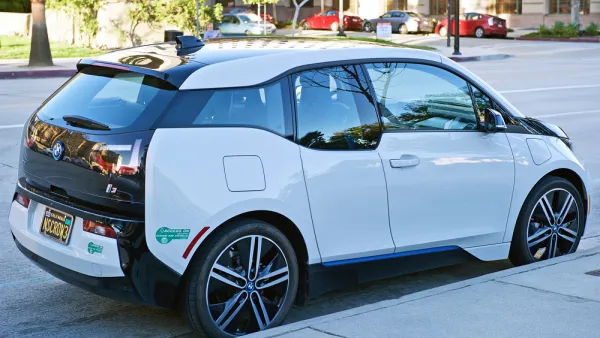A bill working its way through the California State Legislature would require the state to reduce petroleum its consumption by half in 15 years. CALmatters, a nonprofit journalism venture, seeks to find out if it is even possible.
California under Gov. Jerry Brown and its majority Democratic legislature may be more committed to fighting climate change than any other state, and they have legislation to show for it. As posted here in April, SB 350, the Clean Energy and Pollution Reduction Act of 2015 "would (r)educe oil consumption by 50 percent, require renewables to supply 50 percent of electricity generation, and double energy efficiency in existing buildings," all by 2030
Kate Galbraith investigates the possibility of the first goal—halving oil consumption in motor vehicles, for CALmatters, "a nonpartisan, nonprofit journalism venture committed to explaining how California’s state Capitol works and why it matters."
She begins her report at a Stockton fair that promotes electric vehicles (EVs). The event, sponsored by the Charge Ahead initiative, an outcome of SB 1275 that addresses the inherent inequity of the state rebate program by targeting lower income Californians, particularly those with more polluting vehicles.

Credit: Chevrolet 2015 EV Spark
Galbraith speaks with a woman whose 20-year-old Toyota Camry has flunked its smog test. While she's wowed by the all-electric Chevy Spark she test-drove, she chooses to repair the Camry, notwithstanding the generous rebates offered her toward purchase of the Spark.
"If we’re talking about transportation petroleum use, then the goal [to cut use in half by 2030] probably isn’t possible," said John German, a Michigan-based senior fellow with the International Council on Clean Transportation. A key problem, he said, is that people hold onto cars and trucks for a long time, an average of more than 11 years for American cars.
However, that viewpoint is refuted by "Jeffrey Greenblatt, a scientist at the Lawrence Berkeley National Laboratory, [who] estimates that by 2030, a number of transportation policies already in existence will enable the state to cut petroleum use by cars and trucks to about 70 percent of their 2014 level," writes Galbraith. "Besides federal fuel-economy standards, these include support for public transit and a state goal of having 1.5 million emissions-free vehicles by 2025."
In fact, the Charge Ahead initiative enables eligible low income households to "cash in their clunkers and use that voucher with clean car rebates or for car-sharing programs and public transportation," according to Vien Truong, Environmental Equity Director for The Greenlining Institute.
However, "trends are moving in the wrong direction," writes Galbraith. Fuel consumption has been increasing since July 2013. Vehicle miles traveled (VMT) has also been increasing since 2013
So, can technology enable California to meet its oil reduction goal? It can help! In addition to increased electric vehicle sales, "the International Council on Clean Transportation estimates that recent federal fuel-economy standards could cause greenhouse gas emissions from light-duty vehicles nationwide to fall 28 percent by 2030 compared to 2015," writes Galbraith, though that doesn't automatically equate with reduced fuel consumption.
It would be nice to be able to quantify to fuel reduction projected due to:
- Increased EV sales
- Increased fuel efficiency standards
- VMT reduction programs, e.g., public transit
- Low carbon fuel standard, though not mentioned in the article
Notwithstanding Greenblatt's optimistic outlook, it clearly will be difficult for California to cut oil consumption in half, particularly in a time of falling oil prices.
FULL STORY: Can California cut gas use by half in 15 years? Probably not

Analysis: Cybertruck Fatality Rate Far Exceeds That of Ford Pinto
The Tesla Cybertruck was recalled seven times last year.

National Parks Layoffs Will Cause Communities to Lose Billions
Thousands of essential park workers were laid off this week, just before the busy spring break season.

Retro-silient?: America’s First “Eco-burb,” The Woodlands Turns 50
A master-planned community north of Houston offers lessons on green infrastructure and resilient design, but falls short of its founder’s lofty affordability and walkability goals.

Test News Post 1
This is a summary

Analysis: Cybertruck Fatality Rate Far Exceeds That of Ford Pinto
The Tesla Cybertruck was recalled seven times last year.

Test News Headline 46
Test for the image on the front page.
Urban Design for Planners 1: Software Tools
This six-course series explores essential urban design concepts using open source software and equips planners with the tools they need to participate fully in the urban design process.
Planning for Universal Design
Learn the tools for implementing Universal Design in planning regulations.
EMC Planning Group, Inc.
Planetizen
Planetizen
Mpact (formerly Rail~Volution)
Great Falls Development Authority, Inc.
HUDs Office of Policy Development and Research
NYU Wagner Graduate School of Public Service



























